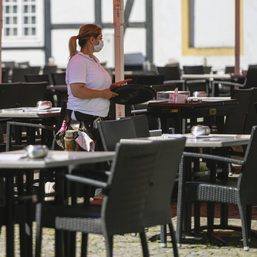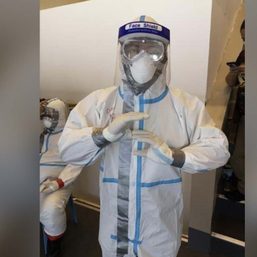SUMMARY
This is AI generated summarization, which may have errors. For context, always refer to the full article.
(Editor’s Note: This story was first published by Newsbreak magazine weeks after the landslide that buried a significant portion of the village of Guinsaugon in St. Bernard, Southern Leyte happened. Its original title in the print version is “Starting Over.”
Rappler is republishing this story under Project Agos to show how the tragedy affected the community.)
MANILA, Philippines – It had been almost two weeks since Romeles “Teteng” Punio received news of the tragedy that took the lives of his wife Marissa and their three children. There were no more tears in his eyes as he recalled the events.
A seaman, Punio was on board his ship on Feb. 17, 2006, when the mountain near his family’s home in Guinsaugon, St. Bernard, Southern Leyte, crumbled and buried the entire village. He heard of the disaster only the following day and was worried sick wondering if his family was safe. “I thought I would go crazy.”
Three days later, Punio came home, not into the waiting arms of his wife and children, but to the crowded classrooms of Cristo Rey High School that temporarily served as the evacuation center for surviving residents. His wife and children were not among the survivors.
Over a thousand people are believed to have perished from the muddy deluge that buried Guinsaugon (estimated population: 2,500).
The disaster drew rescue and relief assistance from several countries, including the US, Malaysia, Spain, and Taiwan. United States Special Forces who were then taking part in Balikatan Exercises were sent to the disaster area to help in the rescue efforts. For a few days, text messages, purportedly from people trapped under the buried structures, fanned hopes that survivors could still be found.
On February 25, eight days after the disaster struck, Southern Leyte Gov. Rosette Yñiguez Lerias announced that they were calling off rescue efforts. By that time, only 137 bodies and 15 body parts have been recovered. Two survivors died while in the hospital and 973 are still missing. They are presumed dead.
Geologists and rescue workers said that the chances of finding survivors in a mudslide are very slim because those trapped inside buried structures would have little supply of air, if at all. The mass of rock, mud, and debris that overwhelmed Guinsaugon was already starting to dry up when Newsbreak visited the area on February 28.
By March 1, practically all the rescuers and other out-of-towners had packed up. Before that, while rescue efforts were still going on, the sleepy town of St. Bernard was a hub of activity, with visitors from far and wide: among them, rescue workers, aid volunteers, and journalists. Local eateries were busier than usual. Rooms at the only resort in town were all taken. Even private homes agreed to take in transients.
The town of St. Bernard is now struggling for normalcy. But many challenges remain.
Relocation plans
Property worth P150 million to P200 million was damaged as a result of the disaster, according to the National Disaster Coordinating Council. Apart from family members and their homes, many survivors have also lost their only source of livelihood—farming. Most residents of Guinsaugon plant either palay, abaca, or coconuts. But what used to be fertile fields are now buried in several meters of rock and thick brown mud.
Students cannot return to school yet because the campuses are still occupied by evacuees. Teachers and school administrators are helping manage the evacuation centers. Apart from Guinsaugon, seven other barangays had to be evacuated while geologists from the Mines and Geosciences Bureau (MGB) evaluated their areas for possible “geohazards.”
MGB geologists have advised the permanent relocation of survivors to the nearby villages of Magatas and Sub-Angon because of danger posed by geohazards like mudslides. Several other villages will have to be partially relocated. The bureau is still assessing the area to identify relocation sites.
International donor organizations have offered support. The commander of the US forces participating in joint exercises with Philippine troops agreed to finance the construction of temporary shelters for the evacuees using Balikatan funds. As local counterpart, St. Bernard Mayor Maria Lim rushed the purchase of a lot where the shelters would be built.
Aid workers from Oxfam and other organizations have encouraged local officials to start addressing pressing needs, like taking care of orphans and vulnerable members of the stricken community, and maintaining health and sanitation in the evacuation centers.
Where have the children gone?
The wounds wrought by the disaster are far from healed. Practically everyone in St. Bernard is related to or knows somebody who perished. At least 31 children were orphaned.
United Nations Disaster Assessment and Control representative Sharon Matale said it is normal for organizations in communities affected by disaster not to function immediately: “How can you function and try to organize people when you’re grieving?”
At the Cristo Rey High School where survivors from Guinsaugon are temporarily lodged, there are very few children. A total of 248 pupils and other children were trapped inside the school building, where a celebration was going on when disaster struck. “Pagdating ng pasukan, wala nang papasok (No more children will go to school),” 30-year old Johnny Coquillas said, hugging his three-year-old daughter, Janna Mae, who was dragged to safety by his mother-in-law. His wife didn’t make it.
Five-year-old Marvin Zamora Jr. is still shaken by the incident and is undergoing counseling. He was lucky. His quick-thinking mother, 30-year-old Melodina, took Marvin—who was playing at that time—in her arms and ran toward neighboring Barangay Magatas after she heard the thundering sound caused by the mudslide. Melodina’s husband, Marvin Sr., and his six-year-old daughter died.
Aid workers noted encouraging signs that St. Bernard is bouncing back. The locals, Matale noted, are already organizing among themselves. Structures are being put back in place “pretty quickly.” This makes it easier, she said, to assess people’s needs. It also gives aid organizations an idea “how and where to plug in.”
It helps that there is very good coordination between the municipal disaster coordinating council and the provincial disaster coordinating council, said Celia Santos of the Community and Family Services International. Relief organizations are represented in these councils.
Many residents of Guinsaugon are starting to accept what happened and are starting to move on.
With the proposed relocation, the disaster area will be transformed into a “sacred sanctuary,” a memorial where no structures will be built, Governor Lerias said.
Near the disaster site, we met Constantino Libaton, who was gathering wood from the rubble to put up a new hut. Libaton’s home used to stand near the center of the village. He lost his wife and a grandchild.
But picking up the pieces will not be that easy. At the municipal hall, Teteng Punio tried to obtain his wife’s death certificate, which he needs in order to claim death benefits. His request was declined. Only a missing person’s certificate can be issued at this time, he was informed. To get the death certificate, he will have to wait a few years more. He cannot understand why this is so. – Rappler.com
Add a comment
How does this make you feel?


There are no comments yet. Add your comment to start the conversation.